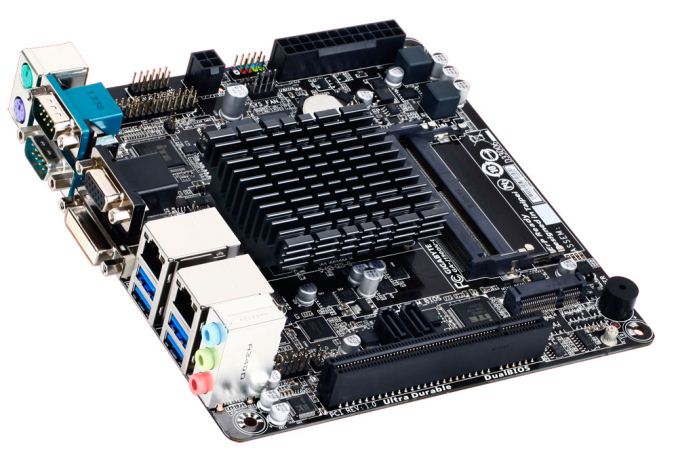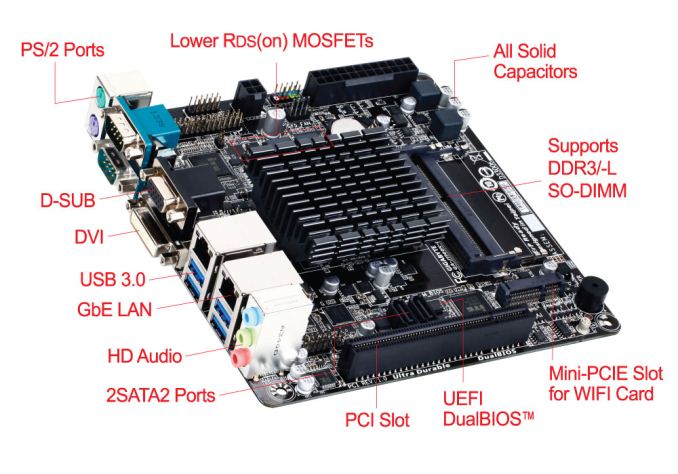The Battle of Bay Trail-D: GIGABYTE J1900N-D3V and ASUS J1900I-C Reviewed
by Ian Cutress on October 17, 2014 10:00 AM ESTGIGABYTE J1900N-D3V Visual Inspection
The J1900N-D3V due to the 10W SoC under the hood uses a passive cooler with plenty of surface area to direct heat away. It is interesting that if we compare this cooler to some of the power delivery heatsinks on mainstream boards, this looks more like a cooler than they do, even though those power delivery heatsinks might actually cost more. Because these motherboards fall under the $100 bracket, little attention is paid to the presentation, although GIGABYTE has at least synchronized the heat sink and the slots to match the PCB. Also for cost reasons, the PCB looks very busy – if an engineer can replace a component with two components and still save money, this becomes the mentality for this sort of design. Every component on board is also surrounded by a white box so the automated machines can be guided onto where each IC or resistor should be.
GIGABYTE has placed the 24-pin ATX and 4-pin CPU power connectors at the edge of the motherboard making it easier to use this board in a case, something their mainstream Z77 and Z87 mini-ITX motherboards had trouble doing. At the top of the board with these connectors are the front panel header, an LPT header and a 4-pin SYS fan header. The motherboard has only two fan headers on board – one just above the SoC and a 3-pin to the left of the SoC, with this one labeled ‘CPU’. This is next to a USB 2.0 header in white.
On the right hand side we have a stacked SO-DIMM arrangement, with each module being placed the opposite way round to each other. As with upgradable laptop SO-DIMM slots, the slots have latches to fasten the modules in place. Below this is a mini-PCIe slot, suitable for a half-length WiFi module which is not included. We also get a built in speaker on the bottom right, something we tend not to see in $100+ products.
At the bottom of the board we have the PCI slot which comes from a PCIe to PCI bridge, with two SATA ports above it. This is a frustrating place to put the SATA ports, as it means a user with two devices will have to reach over the motherboard in order to connect them. The connectors also face the same direction, and if the user decides to have locking cables, the cable on the left needs to be removed before the one on the right can be taken out. To the left of these SATA ports is the front panel audio header.
The rear panel has separate PS/2 connectors for a mouse and keyboard, along with two COM ports, a VGA port and a DVI-D port. GIGABYTE has implemented four USB 3.0 ports by using a Renesas hub, and the two Realtek NICs provide an upgrade over the standard configuration. The 2.1 audio solution is provided by a Realtek ALC887 codec.
Board Features
| GIGABYTE J1900N-D3V | |
| Price | Link |
| Size | Mini-ITX |
| CPU Interface | Soldered |
| Chipset | Bay Trail-D Quad Core |
| Memory Slots | Two DDR3/L SO-DIMM slots supporting up to 8GB Up to Dual Channel, 1333 MHz |
| Video Outputs | VGA (2560x1600) DVI-D (1920x1080) |
| Onboard LAN | 2 x Realtek |
| Onboard Audio | Realtek ALC887 |
| Expansion Slots | 1 x PCI 1 x Mini-PCIe |
| Onboard SATA/RAID | 2 x SATA 3 Gbps |
| USB 3.0 | 4 x USB 3.0 (Hub via SoC) [rear panel] |
| Onboard | 2 x SATA 2 x Fan Header 1 x LPT Header 1 x USB 2.0 Header 1 x mini-PCIe Front Panel Header Front Audio Header |
| Power Connectors | 1 x 24-pin ATX 1 x 4-pin CPU |
| Fan Headers | 1 x CPU (4-pin) 1 x SYS (4-pin) |
| IO Panel | 1 x PS/2 Mouse Port 1 x PS/2 Keyboard Port 2 x COM Ports VGA DVI-D 4 x USB 3.0 2 x Realtek Network Ports Audio Jacks |
| Product Page | Link |
The GIGABYTE J1900N-D3V splits the four PCIe lanes from the chipset into a mini-PCIe slot, a PCIe to PCI bridge and two Realtek NICs. This is perhaps a good scenario for a machine that needs to be networked, although storage users miss out. Other configurations might have revolved around a SATA controller, a PCIe 2.0 x1 slot or a true USB 3.0 controller. But at the price point, users have to bring along their own WiFi and antenna bracket.














60 Comments
View All Comments
Flunk - Friday, October 17, 2014 - link
Yes, but that's like comparing a man with two broken legs to a man with no legs. Yes, the man with the broken legs is faster, but neither is going to be competing in any footraces anytime soon. These are not really suitable for PC gaming.Slap the two of them into tablets and the AMD will run Candy Crush better, but this is the desktop and neither can really manage anything on that level.
AJSB - Friday, October 17, 2014 - link
I said *LIGHT* gaming....i also specified a certain resolution up to 1366x768 (forget about 1920x1080).It all depends the kind of titles it plays....many indies will play just fine...and so it will MANY of the "old" titles like CoH (NOT CoH2), CoD2, BF2,etc. at those resolutions....lot's of people still play at least CoD2 online (and doesn't have those crazy UAV/HELIs in MP) and theres lots of mods for CoH and BF2 to play online or offline (i actually prefer play those offline).
Having said so, i play with a A6-5400K OC to 4GHz w/ iGPU OC to 950MHz and 8GB RAM at 2133MHz (CPU, iGPU and RAM were all undervolted to cut temps and power drain).
This rig gives me more freedom to play more demanding titles that i doubt a AM1 could.
PICman - Friday, October 17, 2014 - link
As usual, good review. However, as XZerg pointed out, the lack of idle and load power consumption is a problem. It's not just power consumption, but also heat generation and cooling. I guess the tests were run with a high wattage power supply, making idle power measurements meaningless?Non-working USB 3.0 ports is a big issue for me, also.
Torpe - Friday, October 17, 2014 - link
How well do these chips do with Quick Sync for Handbrake?Devo2007 - Saturday, October 18, 2014 - link
Did you read the part that mentioned these are the B3-stepping processors that don't have QuickSync?abufrejoval - Tuesday, October 21, 2014 - link
My GIGABYTE J1900N-D3V wasn't properly informed about that "fact" and just runs QuickSync anyway... Actually the initial Intel chipset drivers didn't enable QuickSync and I was quite hopping mad, because ARK had reported QuickSync support for the J1900, irrespective of the stepping.Actually I believe that the QuickSync feature gap lies between the J1850 and the J1900 and isn't stepping dependent.
abufrejoval - Tuesday, October 21, 2014 - link
Need edit!Fortgot to mention: It's a B3 stepping and runs around 80 frames/sec of DVD to MP4 conversion using DVDFab9 using QS. The QuickSync enabled Handbrake nightly builds I tried produced faulty output and the last stable release doesn't yet support QS.
Batch video conversion isn't exactly the forte of this device, but it would make it a credible Plex server once QS support for encoding is built in (for devices that need the run-time conversion).
Torpe - Tuesday, October 21, 2014 - link
Thanks for the answer.BillyONeal - Friday, October 17, 2014 - link
Windows 7 needs USB 3 drivers because Win7 has no USB 3 support. That was added in Win8.nathanddrews - Friday, October 17, 2014 - link
"Readers of our motherboard review section will have noted the trend in modern motherboards to implement a form of MultiCore Enhancement / Acceleration / Turbo on their motherboards."It's funny the difference between what turbo means today vs what it meant 30 years ago. My first PC (running Geo-DOS) had a "TURBO" button on the case that slowed it down. LOL
I've been using a Windows 8.1 (Bing) tablet with an Atom Z3735D and it's really impressive. It plays UT99 and Halo CE flawlessly at max res and settings (1280x800) and can stream games over Steam IHS. I played Halo for four hours nonstop and still had 30% battery left.